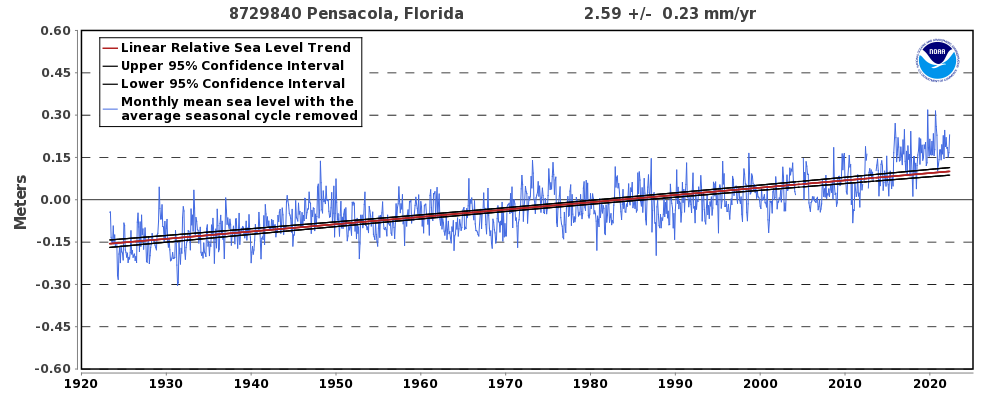An article by an Associated Press (AP) reporter picked up by the Chicago Sun Times claims that climate change is threatening brown pelicans in Louisiana. Evidence suggests this claim is likely false.
The AP article claims increases in storm frequency and intensity, sea level rise, and resultant erosion of barrier islands along the Louisiana coast, is threatening the habitat of the marine bird. Data refute the claim that tropical storms are becoming more frequent or intense. In addition, sea level rise is within the natural rate of rise it has been since exiting from the last ice age. Coastal erosion is a natural process, arguably exacerbated by human development along the coast.
The article, “Climate change, vanishing islands in Louisiana threaten brown pelicans,” written by AP reporter Christina Larson says that 12 years ago there were 15 small, low-lying islands that were home to nesting populations of brown pelicans, but now “only about six islands in southeastern Louisiana harbor brown pelican nests — the rest have disappeared underwater.”
Later in the article, it is explained that brown pelicans prefer to nest in “mangrove penthouses,” with only some birds nesting on the ground where they are more at risk of flooding and predators. There is no shortage of mangrove or other tall trees in coastal South Louisiana—there is little reason to think that these specific barrier islands are the sole available habitat for flying marine birds.
Larson writes that “rising seas and increased storm frequency and intensity linked to climate change accelerate the pace. And the islands have been starved of new sediment from the Mississippi River because its course has been controlled since the 1940s with levees to prevent flooding and aid shipping.”
There are many factors outside of climate change that contribute to the shape of Louisiana’s coastal swamps and islands, several of which are rightly pointed out in this very article, which makes the titular claim all the more confusing.
Climate Realism has refuted the oft-repeated claims that tropical storms and hurricanes are getting more severe dozens of times, here, here, and here, for example. Hurricane data show that there has been no statistically measurable increase hurricane frequency or severity over the past half century. Indeed some research even suggests that the number of yearly tropical cyclones may actually be decreasing over time.
The rate and direction of sea level change varies by region, and while the overall global trend is towards rising sea levels, the rate is within the historical natural range experienced by the earth since it exited the last glacial period more than 12,000 years ago. Climate at a Glance: Sea Level Rise, presents data demonstrating that the one-foot-per-century rate of rise has been relatively consistent since the mid-19th century. Regionally, tide gauge data in Grand Isle, LA, show a relatively fast rate of sea level rise, at just over 9 mm per year. (See Figure 1 below)

Pensacola Florida, however, just a few hours’ drive away from Grand Isle, shows a much smaller rise of only 2.59 mm per year. (Figure 2)

In fact, Grand Isle has the highest rate of “sea level rise”—most likely due to subsidence —in the continental United states, according to National Oceanographic and Atmospheric Administration data.
Regardless of human activity, the Louisiana coastline has long been a highly dynamic environment. Every tidal cycle changes the shape of the thousands of small islands and estuaries. The Louisiana coast is not like the long stretches of beaches that you find in parts of Texas and much of Florida; as a river delta environment, it is shaped largely by the Mississippi river dumping sediment and moving water.
The comment from the article related to islands “starved” of sediment due to civil engineering projects controlling the Mississippi flood plains and movement may very well be part of the problem, but that’s not climate change. Coastal development and channels dredged through the coastal wetlands are likely culprits contributing to the declining barrier marshlands. In addition, like other river deltas, Louisiana’s coast has low elevation, extended floodplains, and is prone to erosion and land sublimation, especially since the regular addition of sediment, delivered by the Mississippi annually to the marsh area has been prevented to control flooding and help shipping. Climate Realism previously discussed this very same issue in the Volta River Delta of Ghana, here, where major issues with land subsidence in Ghana’s coastline accelerated after dams were built upstream in the Volta river.
Another factor widely recognized as contributing to the erosion of Louisiana’s coast has been the introduction of the voracious South American transplant, the rodent nutria. Brought to Louisiana from South America for the fur trade, which collapsed, as detailed in a Business Insider article millions of these beaver sized rodents are destroying coastal Louisiana, “chomping [their] way through the state’s wetland vegetation and removing the plants and grasses that are critical to preventing these marshes from turning into open water.” The damage nutria are doing to Louisiana’s coast is so bad the state offers a bounty to encourage hunters and trappers to remove them.
Building up barrier islands is a worthy cause; they help protect low-lying Louisiana against hurricane related storm surge and natural sea level rise. If these islands also make good habitat for brown pelicans and other marine birds, all the better. However, it is cynical and misleading to try to blame climate change for any decline in brown pelican nests.
















